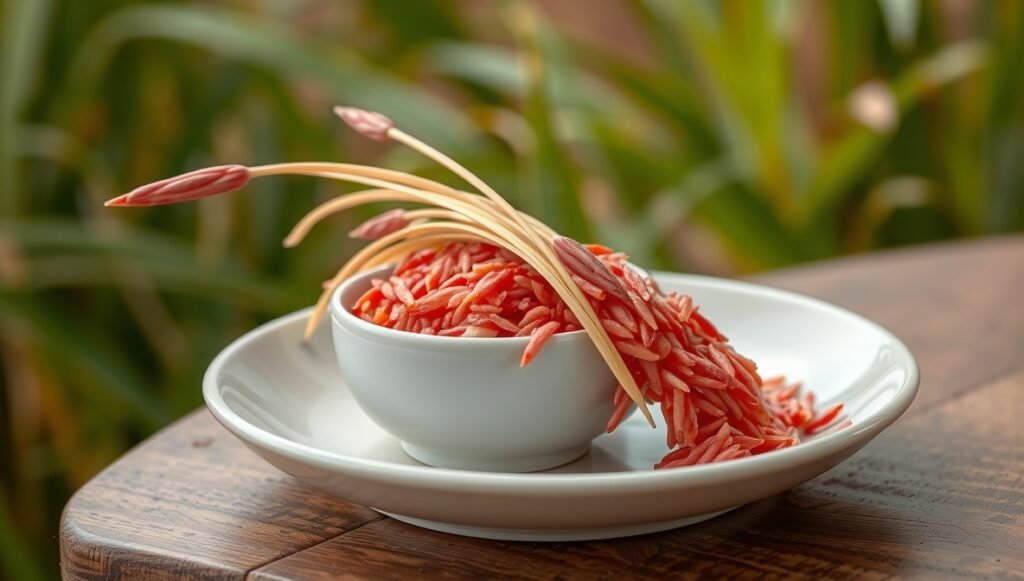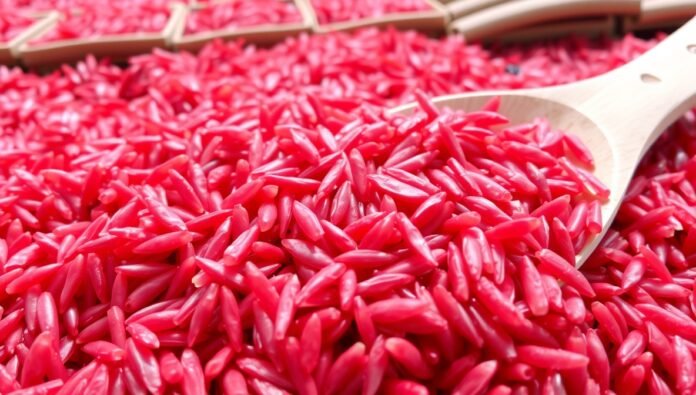Red rice is a special type of rice that comes with a reddish color and a nutty taste. The color of red rice comes from a natural pigment called anthocyanin, which is also found in many fruits and vegetables. People love red rice because it is full of nutrients and is great for health. Red rice is not only tasty but also very good for the heart, skin, and overall energy. It gives a filling meal that keeps you active for hours. More and more people are now choosing red rice instead of white rice because of its rich flavor and health power.
Red rice is also known as a whole-grain rice that keeps its outer layer full of fiber and minerals. This helps in easy digestion and gives strength to the body. Many traditional Asian dishes use red rice for its natural color and healthy benefits. You can cook red rice just like normal rice, but it gives a stronger taste and softer texture. Eating red rice often can help manage weight, lower sugar levels, and improve blood flow. It’s a smart choice for anyone who wants to eat healthy without giving up on taste. In this blog, we’ll explore how red rice can become your next favorite superfood.
Amazing Health Benefits of Red Rice
Red rice is packed with health benefits that make it stand out from other rice types. One of the biggest advantages of eating red rice is that it helps improve heart health. The antioxidants in red rice protect your heart and reduce bad cholesterol levels. It is also rich in magnesium, which helps keep your blood pressure under control. Eating red rice regularly can also make your bones stronger because it contains a good amount of calcium and zinc.
Another great benefit of red rice is its ability to help with weight loss. The high fiber in red rice keeps you full for a long time, so you don’t feel hungry quickly. This means you can eat less without feeling tired or weak. The slow-releasing carbs in red rice give you energy for hours, making it a smart food choice for people who want to stay fit. Red rice also improves digestion and prevents constipation because of its natural fiber. It even helps in reducing inflammation in the body, keeping your skin fresh and glowing.
Red Rice vs White Rice: Which One Is Better for You
When you compare red rice with white rice, the difference is clear. White rice is polished and processed, which means it loses many nutrients during cleaning. Red rice, on the other hand, is unpolished and keeps its outer layer, which is full of fiber, vitamins, and minerals. Because of this, red rice has more health benefits and gives more energy for a longer time.
White rice is soft and easy to cook, but it mostly provides empty calories. Red rice takes a little more time to cook, but it gives much more nutrition and keeps you satisfied longer. People with diabetes or high cholesterol can benefit from red rice because it helps control sugar and fat levels naturally. If you are looking for a healthy change in your diet, switching from white rice to red rice is a smart move. It supports good health, better digestion, and a stronger immune system.
How to Cook Red Rice the Right Way at Home

Cooking red rice is very simple, but it needs a little extra soaking time because of its thick outer layer. First, wash the rice properly to remove any dust or extra starch. Then soak it in water for about 30 minutes before cooking. This helps the grains become soft and cook evenly.
To cook red rice, use a ratio of 1 cup of red rice to about 2½ cups of water. You can cook it in a rice cooker or on the stove. Boil the water, add the rice, and let it cook on low flame for 25 to 30 minutes. Once it becomes soft and the water is absorbed, let it rest for a few minutes. Fluff the rice gently with a fork before serving. You can also steam it or use a pressure cooker for faster results. Red rice goes well with curries, vegetables, and soups. It adds a nutty flavor and a beautiful color to your plate.
Red Rice Nutrition Facts That Will Surprise You
Red rice is a powerhouse of nutrition. It contains high levels of fiber, protein, iron, and antioxidants that keep your body strong. One cup of cooked red rice provides around 110 calories, 23 grams of carbohydrates, and about 2 grams of protein. It is low in fat and contains no cholesterol, which makes it an ideal food for heart health.
The anthocyanin in red rice gives it its deep red color and powerful antioxidant benefits. These antioxidants help fight free radicals, which can damage your cells. Red rice also has more zinc, magnesium, and potassium than white rice. These minerals help your body stay balanced, support your muscles, and improve metabolism. If you are looking for a natural and healthy grain to add to your diet, red rice is one of the best options available.
Why Red Rice Is a Great Choice for Weight Loss
If you are trying to lose weight naturally, red rice can be a great addition to your diet. The high fiber in red rice makes you feel full for a longer time, so you eat less overall. It also prevents unhealthy snacking between meals. Because red rice digests slowly, it gives steady energy without raising your blood sugar quickly.
This slow digestion is very helpful for people who are on a weight loss journey. It keeps energy levels stable and helps the body burn fat more efficiently. Red rice also improves gut health, which supports better digestion and nutrient absorption. Unlike white rice, which can cause sugar spikes and make you hungry faster, red rice helps maintain steady blood sugar levels. Eating red rice a few times a week can make a noticeable difference in your weight management plan.
How Red Rice Helps in Managing Blood Sugar Naturally
Red rice is an excellent food for people with diabetes or those who want to control their blood sugar naturally. It has a low glycemic index, which means it does not cause a sudden rise in blood sugar levels. The fiber in red rice slows down sugar absorption in the bloodstream, keeping it steady throughout the day.
The natural antioxidants and magnesium in red rice also support insulin function, helping your body use sugar properly. Replacing white rice with red rice can be a smart step toward a balanced and healthy lifestyle. You can pair it with vegetables, lentils, or grilled food to make a delicious and diabetic-friendly meal. Eating red rice regularly can reduce sugar cravings and support better health without giving up on taste.
Tasty and Simple Red Rice Recipes for Everyday Meals
There are many fun and easy ways to enjoy red rice in your daily meals. You can use it as a base for salads, stir-fries, or curries. One simple dish is red rice with vegetables. Cook your red rice, then stir-fry it with carrots, beans, onions, and spices for a colorful, healthy bowl.
You can also make red rice porridge for breakfast by boiling it with milk or coconut milk and adding honey or fruits for flavor. Another great option is red rice pulao, where you cook the rice with spices, peas, and herbs. Red rice also tastes amazing when mixed with lentils to make a healthy khichdi. These recipes are easy, filling, and full of nutrition. They prove that eating healthy can be delicious and fun at the same time.
The Secret Behind the Red Color of Red Rice
The beautiful red color of red rice comes from a natural pigment called anthocyanin. This pigment is a type of antioxidant that also gives color to foods like cherries, purple corn, and grapes. Anthocyanins are very helpful for the body because they protect cells from damage and support heart and brain health.
This natural pigment is found mostly in the outer layer of red rice, which is why unpolished rice has a darker color and more nutrients. The red color is not just for looks—it is a sign of the rice’s strong nutritional value. The more intense the color, the higher the antioxidant power. This makes red rice a beautiful and healthy grain to add to your meals every week.
Best Ways to Add Red Rice to Your Daily Diet
Adding red rice to your daily diet is easy and enjoyable. You can replace white rice with red rice in any dish you like. Use it in your lunch, dinner, or even breakfast bowls. Red rice pairs well with vegetables, chicken, fish, or lentils. You can also mix it with brown or black rice for more texture and color.
Try using red rice in soups or salads for a crunchy twist. If you love desserts, red rice pudding made with coconut milk is a tasty and healthy treat. Red rice can also be used in sushi, wraps, and fried rice recipes for a fun change. With so many creative options, you can enjoy red rice in different ways without getting bored. Eating it a few times a week can bring visible health improvements.
Conclusion
Red rice is a simple grain with amazing power. It’s rich in nutrients, fiber, and antioxidants that support heart health, weight management, and blood sugar control. Unlike white rice, red rice gives long-lasting energy and helps the body stay healthy in many ways. Its natural color, strong flavor, and health benefits make it a superfood that fits perfectly in modern diets. By adding red rice to your meals, you not only make your plate colorful but also make your body stronger from within.
FAQs
1. What makes red rice different from white rice?
Red rice is unpolished and keeps its outer layer, which has fiber and nutrients. White rice is polished and loses most of its natural goodness.
2. Is red rice good for weight loss?
Yes, red rice is high in fiber and keeps you full longer, helping reduce hunger and support weight loss naturally.
3. Can people with diabetes eat red rice?
Yes, red rice has a low glycemic index, which helps manage blood sugar levels effectively.


